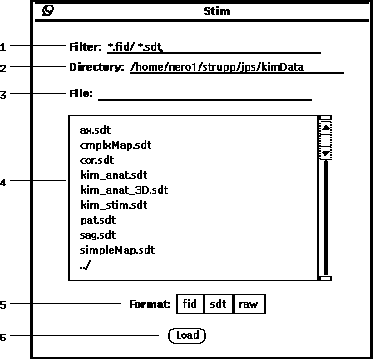
Figure 7: File Browser popup window
The file browser, as shown in Figure 7, is a general purpose popup window that is used for loading and saving files to disk.
The (7-2) field specifies the current directory to be used to obtain a set of file and subdirectory names. The (7-1) field is used to specify a subset pattern to limit which names are used in filling the scrolling list (7-4).

Figure 7: File Browser popup window
The filter specification can be one or more selection patterns to form a subset of file names from the current directory. Filter patterns are composed of combinations of the three special characters, star ('*'), question mark ('?') and slash ('/'), along with alphanumeric characters. The meaning of the special characters is given in Table 2.

Table 2: Filter pattern special characters.
Whenever an entry in the scrolling list is selected, the name appears in the field (7-3). A trailing slash is appended to the names of subdirectories in the scrolling list. The current directory can be changed either by typing a new path in the Directory field and hitting the return key or by double clicking on any selected directory entry in the scrolling list. Note that the parent directory, indicated by double dots with a slash ('../'), is always an entry in every directory listing.
Environment variables can also be used to specify directory names by prepending
the variable name with a dollar sign (e.g. $PWD or $HOME).
Custom environment variables can be specified with the UNIX command setenv.
Any user's home directory can be specified by prepending that user's login
name with a tilde (e.g. ![]() strupp ).
strupp ).
Pressing the button (7-6)
will load or save the specified file as the case may be.
One exception is when exporting an image using an
menu (5-3) item and is
detailed in Section 18.
Another exception is when loading an file, then pressing
the button (7-6) will result in a second popup
window being displayed dependent on
the choice (7-5) selected.
See Section 6 for a discussion about image file formats.
When saving an image file, an additional choice of
(not shown) is displayed with two
options: ``Real (4 Byte Float)'' and ``Word (2 Byte Short),''
The ``Word'' data type results in a file that is half the size
than that of ``Real.''
To minimize the potential loss of intensity resolution, the
image values are scaled to the full ![]() range.
range.